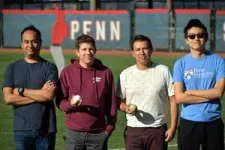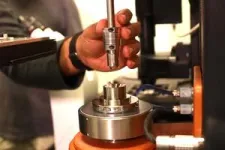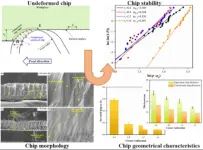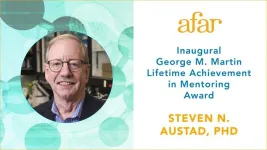(Press-News.org) A team led by researchers at the University of Toronto has uncovered new targets that could be the key to effectively treating glioblastoma, a lethal type of brain cancer. These targets were identified through a screen for genetic vulnerabilities in patient-derived cancer stem cells that represent the variability found in tumours.
Glioblastoma is the most common type of brain cancer in adults. It is also the most challenging to treat due to the resistance of glioblastoma cancer stem cells, from which tumours grow, to therapy. Cancer stem cells that survive after a tumour is treated go on to form new tumours that do not respond to further treatment.
“Glioblastoma tumors have evaded treatment thus far because their composition is highly variable both within and between tumours,” said Graham MacLeod, co-first author on the study and senior research associate of U of T’s Donnelly Centre for Cellular and Biomolecular Research. “The tumours vary quite a bit from person to person, and even within a single tumour there are multiple cell types that harbour differences at the genetic level.”
The study was published recently in the journal Cancer Research.
A key finding of the research is that the variability among glioblastoma cancer stem cells can be observed across a gradient between two cell subtypes. On one end is the developmental subtype, which resembles cells in which normal neurodevelopment has gone awry, and on the other end is the injury-response subtype, which is an inflammatory state. The aim of the study was to identify potential treatment methods to target each subtype, thereby tackling tumours in a more holistic manner.
This study follows earlier research published in Cell Reports that identified vulnerabilities in glioblastoma cancer stem cells that impact their sensitivity to chemotherapy. The next step within this line of research was to study how vulnerabilities in glioblastoma cancer stem cells vary in a large and diverse set of patient-derived cell lines to identify the most common of these vulnerabilities in each of the subtypes.
The team performed CRISPR/Cas9 screens in glioblastoma stem cell lines from 30 patients, making this the largest screening study of its kind. The patient-derived cell lines were generated by the lab of Peter Dirks, professor of surgery and molecular genetics and Chief of the Division of Neurosurgery at SickKids. Within the cancer stem cell samples, the team found genes responsible for the proliferation of the two cell subtypes that could be targeted to prevent tumour growth. Combining drugs to target both cell subtypes simultaneously could potentially make for a more effective glioblastoma treatment.
“A lot of the research on glioblastoma is conducted with a limited number of immortalized cell lines grown in serum,” said Fatemeh Molaei, co-first author on the study and graduate student at the Donnelly Centre and the Leslie Dan Faculty of Pharmacy. “These cells aren’t the best model as they don’t resemble true glioblastoma cells as much as we would like. The findings from our study represent what we see in a patient’s tumour more accurately because our cell lines are derived directly from a large group of patients. It’s through our screens of this group of cell lines that we were able to identify the OLIG2 and MEK genes as drug targets for the developmental cell subtype and the FAK and B1-Integrin genes as targets for the injury-response subtype.”
“It’s been established that there are different subtypes of glioblastoma stem cells, but their differences are not being addressed in the clinic,” said Stéphane Angers, principal investigator on the study and director of the Donnelly Centre.
“In the future, our results will help in designing new treatments that are tailored to patients by targeting the predominant cell subtype, or both subtypes simultaneously,” said Angers, who is also a professor in the Leslie Dan Faculty of Pharmacy and U of T’s Temerty Faculty of Medicine. “The ability of glioblastoma to adapt to therapeutic treatment is its greatest strength and our biggest challenge. Our study increases our understanding of this type of cancer and proposes a different approach to treating it that will hopefully improve the prognosis of patients.”
This research was supported by the Canadian Institutes of Health Research.
END
Researchers home in on tumor vulnerabilities to improve odds of treating glioblastoma
2024-11-04
ELSE PRESS RELEASES FROM THIS DATE:
Awareness of lung cancer screening remains low
2024-11-04
There is a lung cancer screening test that is saving lives – and yet most people who could be getting the test have never heard of it or never talked about it with a doctor.
“We’ve got a screening test that works. It works as well, if not better, than breast and colorectal cancer screening in terms of mortality reduction. It's one of the most life-saving things we have for a cancer that kills more people than either of those two combined,” said lung cancer pulmonologist Gerard Silvestri, M.D. And yet, he said, “Eighty percent of those eligible for this screening, regardless of race, education, ethnicity, health or income, hadn’t heard of or ...
Hospital COVID-19 burden and adverse event rates
2024-11-04
About The Study: In this cohort study of hospital admissions among Medicare patients during the COVID-19 pandemic, greater hospital COVID-19 burden was associated with an increased risk of in-hospital adverse effects among both patients with and without COVID-19. These results illustrate the need for greater hospital resilience and surge capacity to prevent declines in patient safety during surges in demand.
Corresponding Author: To contact the corresponding author, Mark L. Metersky, MD, email metersky@uchc.edu.
To access the embargoed study: Visit our For The Media website at this link https://media.jamanetwork.com/
(doi:10.1001/jamanetworkopen.2024.42936)
Editor’s ...
NSF NOIRLab astronomers discover the fastest-feeding black hole in the early universe
2024-11-04
Supermassive black holes exist at the center of most galaxies, and modern telescopes continue to observe them at surprisingly early times in the Universe’s evolution. It’s difficult to understand how these black holes were able to grow so big so rapidly. But with the discovery of a low-mass supermassive black hole feasting on material at an extreme rate, seen just 1.5 billion years after the Big Bang, astronomers now have valuable new insights into the mechanisms of rapidly growing black holes in the early Universe.
LID-568 was discovered ...
Translational science reviews—a new JAMA review
2024-11-04
About The Article: To help clinicians keep up with ongoing basic and translational science discoveries that affect the diagnosis and treatment of human disease, JAMA has launched a new series, “Translational Science Reviews.” These new article types are succinct and informative summaries of important basic science advances that are transforming diagnosis and treatment of human disease.
Corresponding Author: To contact the corresponding author, Mary M. McDermott, MD, email mdm608@northwestern.edu.
To access the embargoed study: Visit our For The Media website at this link https://media.jamanetwork.com/
(doi:10.1001/jama.2024.21146)
Editor’s Note: Please ...
How the keto diet could one day treat autoimmune disorders
2024-11-04
Scientists have long suspected the keto diet might be able to calm an overactive immune system and help some people with diseases like multiple sclerosis.
Now, they have reason to believe it could be true.
Scientists at UC San Francisco have discovered that the diet makes the gut and its microbes produce two factors that attenuated symptoms of MS in mice.
If the study translates to humans, it points toward a new way of treating MS and other autoimmune disorders with supplements.
The keto diet severely restricts carbohydrate-rich ...
Influence of tool corner radius on chip geometrical characteristics of machining Zr-based bulk metallic glass
2024-11-04
Different from traditional alloys, BMGs exhibit a unique atomic arrangement characterized by short-range order and long-range disorder at the atomic level. Such atomic structure leads to the absence of defects such as grain boundaries and dislocations, resulting in exceptional mechanical properties. The promising properties of BMGs have rapidly positioned them as a new class of structural and functional materials, showing great application potential in various fields including structural, energy and chemical engineering. In order to facilitate their engineering applications, research has reported their cutting characteristics from various aspects, ...
Megan Huisingh-Scheetz, MD, MPH, of the University of Chicago recognized with AFAR’s Terrie Fox Wetle Rising Star Award in Health Services and Aging Research
2024-11-04
New York, NY – The American Federation for Aging Research (AFAR), is proud to recognize the outstanding contributions of Megan Huisingh-Scheetz, MD, MPH, with the 2024 Terrie Fox Wetle Rising Star Award in Health Services and AgingResearch.
This award honors a health services researcher in an early or middle phase of his/her career who has already made importantcontributions with work that respects the value of multidisciplinary health services science and that ...
Steven N. Austad, PhD, to receive inaugural George M. Martin Lifetime Achievement in Mentoring Award
2024-11-04
New York, NY–The American Federation for Aging Research (AFAR) is pleased to announce the recipient of the inaugural George M. Martin Lifetime Achievement in Mentoring Award: Steven N. Austad, PhD, Protective Life Endowed Chair in Healthy Aging Research and a Distinguished Professor in the Department of Biology at the University of Alabama at Birmingham (UAB).
The Award is named in honor of George M. Martin, MD (1927-2022), a pioneer in the field of aging research and AFAR’s Scientific Director for more than a decade. A Professor of Pathology at the University of Washington, Dr. Martin devoted his long, distinguished career to growing the field of aging ...
Jeremy D. Walston, MD, of Johns Hopkins University to receive AFAR 2024 Irving S. Wright Award of Distinction
2024-11-04
New York, NY – The American Federation for Aging Research (AFAR), is pleased to recognize the exemplary contributions of Jeremy D. Walston, MD, to the field of aging research through the 2024 Irving S. Wright Award of Distinction. This award is named in honor of AFAR’s founder and recognizes exceptional contributions to basic or clinical research in the field of aging. Established in 1982, the award is a framed citation and carries a cash prize of $5,000.
Dr. Walston, the Raymond and Anna Lublin Professor of Geriatric Medicine at Johns Hopkins University (JHU), holds multiple leadership roles at JHU, including Director of the Human Aging Project, ...
SwRI receives $23 million in U.S. Air Force contracts to sustain aging aircraft
2024-11-04
SAN ANTONIO — November 4, 2024 —Southwest Research Institute has received two contracts totaling $23 million from the U.S. Air Force for a program to address aging aircraft structures and material degradation. Under these contracts, the Institute will help the Air Force modernize methods to sustain the T-38 Talon, the A-10 Thunderbolt and the B-52 Stratofortress. All three military aircraft first came into service more than 45 years ago.
“SwRI will assist with the full spectrum of structural sustainment for these aircraft,” said Luciano Smith, manager of SwRI’s Structural Integrity Group. “Our analyses will help the Air Force know ...








